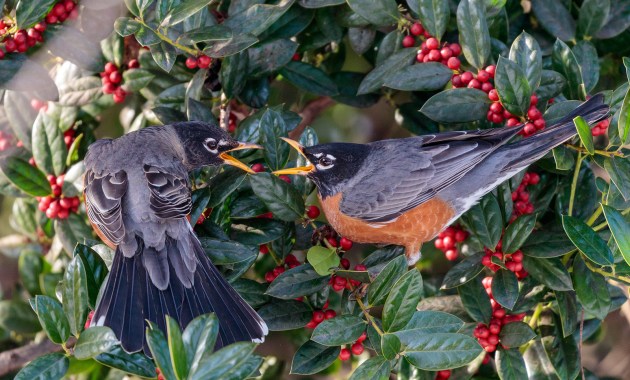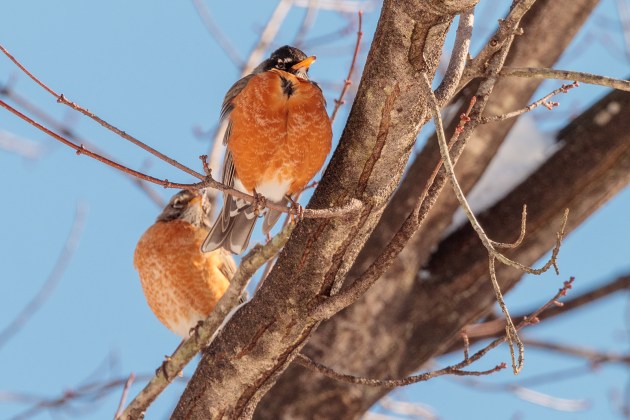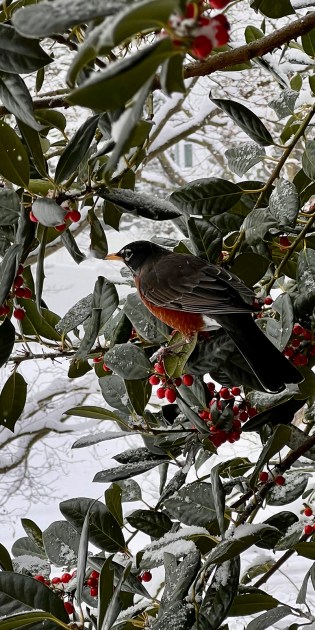It’s winter in Maryland. In fact, it’s so much winter I shoveled 10 inches of snow off my driveway this morning. Fortunately, I had company. It wasn’t the kind of company that picks up a shovel and helps out, but still, the American robins darting back and forth over my head were still welcome (if surprising and surprisingly quiet) snow day companions.
Become a Member
Make a lasting impact for nature when you join The Nature Conservancy
“You know,” I said to them as I leaned on my shovel to watch about 25 birds flock together in my neighbor’s oak. “I think y’all are a little early—aren’t you supposed to be the first harbingers of spring?”
We’re not even a month past the first day of winter in the northern hemisphere. Spring is definitely not here. So why are the robins? Shouldn’t they be sunning themselves in warmer climes?
The short answer: as long as there’s food, American robins—true to their name Turdus migratorius (“the wandering thrush”)—kind of spend their winters coming and going as they please.
Robin Migration (AKA Robin Wandering)
Robins do migrate—but they don’t necessarily follow a more or less straight line from north to south in the fall, then repeat the journey south to north in the spring. In the fall and winter, when the ground freezes, robins lose access to their meal of choice: worms, insects (adult and larval) and (occasionally) snails. That’s when they turn to their winter diet staple: mostly fruit, mostly berries.
The folks at Journey North, a project tracking robin movements run by the University of Wisconsin-Madison, put it this way, “Some robins retreat all the way to southern Texas and Florida (in fact, some of the largest winter flocks documented by the Christmas Bird Count gather in sunny St. Petersburg, Florida), but others winter as far north as they can find berries. So they have an enormous winter range. Robins do migrate, but it has more to do with food sources than with being faithful to the same places year over year.”
In that way American robins are somewhat akin to teenage boys—they tend to go where the best (or most abundant or most easily accessible) food is, stay until it’s depleted, and then move on.
So as long as there are enough berries and other fruits to sustain them, you may see robins off and on throughout the winter across much of North America.
Forget the birdseed though. Robins’ digestive systems, unlike sparrows or other so-called feeder birds, aren’t built for dealing with seed, and their beaks aren’t built for cracking things open. Robin beaks are built for snapping up worms, catching insects, and plucking berries and other fruits. In the winter, a flock of robins can strip a holly bush with impressive speed and efficiency, and very little—if any—violent robin-on-robin aggression.
Food is also one of the reasons that robins, notoriously territorial and aggressive in breeding season, tend to gather and travel in flocks in the fall and winter. Numbers are good for defense, and also for spotting food—if one robin happens on a holly tree full of bright, ripe berries, the whole flock can partake. And then move on.
The tendency of robins to flock in winter may also be one of the reasons people seem to notice them—birds in large numbers tend to stand out when they’re gathered in leafless trees. (That and the beautiful red breast that is sometimes the only splash of color in a winter landscape that looks practically lunar in relentless shades of February white and gray.)

How do Robins Survive the Cold?
Robins are outfitted to survive huge temperature variances. In fact, hot weather seems to stress them more than cold.
If an American robin is healthy, has enough to eat, and is able to main its feathers, the temperature next to its body stays around 104 F—regardless of how cold it is in the world outside. It really is all about those feathers. (And the legs and feet.)

Robins, like most birds, have layers of feathers that perform different functions. When temperatures drop, robins puff the fine, downy feathers closest to their bodies to keep heat in, cold out. The outer feathers act like a kind of overcoat, shedding water and moisture and helping to regulate the bird’s temperature. (It’s an adaptation not limited to robins. Most birds with down feathers fluff them to regulate body heat).
The anatomy of a robin’s (and other bird species) also contributes to their cold adaptations. The bird experts over at the Cornell Lab explain it very well. The simplified version is that “most birds don’t succumb to frostbite because there is so little fluid in the cells of their feet, and their feet are mostly tendons and bones with little muscle or nerve tissue.”
So while blood does flow to their legs and feet, most birds (including robins) benefit from a very fast circulatory system and a “countercurrent heat exchange system.” Because bird legs are thin, the vessels that move blood from the heart to the feet and back again are very close together. That proximity means, per Cornell, “blood flowing back to the body is warmed by blood flowing to the feet. The newly cooled blood in the feet lowers heat loss from the feet, and the warmed blood flowing back into the body prevents the bird from becoming chilled.”
Robins: The Tell-Tale Birds of Spring
If robins are around in winter, why have they always been associated with the beginning of spring in the U.S.? Most likely it has to do with ground thaw, snow melt, and territorial behaviors like singing, worm hunting and nest building. But mostly, it’s the singing.
According to Journey North, which has a fantastic Q+A section I highly recommend for the robin-curious, “the robin’s song remains a reliable indicator that the first wave of spring migration has reached you. This song is one of the first signs that robins are switching from winter behavior to courtship and nesting behaviors associated with spring.”
Robins tend to move north as the ground thaws. The availability of high protein prey, especially worms that emerge with warmer, often wetter weather, is when a robin’s thoughts turn to procreation. And that’s the end of the cooperative fall and winter behaviors.

Which is one of the reasons many robins (primarily males) may stay through harsher winters instead of booking it to St. Petersburg: first access to the choicest nesting grounds. Breeding season is when robins also become more visible with mating displays, nest-building and a lot of time on the ground hunting for the tastiest worms. Until then, they’re all about the berries.
You Can Help Robins with Science from Your Own Backyard
Like many species, including other birds, scientists are starting to see some changes in robin behavior that is likely attributable to climate change. One study of American robins migrating to and from Canada’s boreal forest, showed that they’re beginning to journey south on average about 12 days earlier than in past years, or five days earlier per decade since 1994.

If you want to help scientists studying birds, there are several ways to contribute your observations (not just for robins, but for many of the species you can see outside your windows).
Journey North
You can submit your robin observations directly on the Journey North site (and check out their other migration-related citizen science projects). They also have 2025 maps tracking sightings so you can see where American robins (and other signs of spring) are being observed and follow along (and contribute to) the wanderings of Turdus migratorius.
Cornell Lab of Ornithology
The Cornell Lab has a number of different ways you can contribute to science for birds. Your sightings tracked on eBird (free) contribute to worldwide data for birding, science, and conservation. Want to know what birds are being seen in your neighborhood, eBird has a feature for that. If you’re new to birding, check out their genius birding ID app, Merlin.
You can also contribute to Project FeederWatch (requires subscription) by counting birds at your feeder from November through April. Your observations help scientists monitor changes in the abundance and distribution of birds, including the influence of changes in habitat, disease, and climate.
And mark your calendars for the 2025 Great Backyard Bird Count (February 14-17). Spend time in your favorite places watching birds—then report them to Cornell! It’s easy to participate, “in as little as 15 minutes notice the birds around you. Identify them, count them, and submit your counts to help scientists better understand and protect birds around the world. You can see the results from 2024 here.




I live in Watauga Texas and I have had a flock of 15 to 20 Robins in my yard the past week. Today the snow has melted pretty much and they’ve evidently been getting worms and bugs out of the ground. When they take off flying they zoom from place to place then land and search for food again. First time I’ve seen so many in one place at the same time.
This week in Dallas, during the huge winter storm, our neighborhood had hundreds of robins in a flock show up, and go en masse from street to street looking for berries. We put out water for them and they drank like they were very thirsty. What a sight that was!
Last spring, a robin’s nest was built on our front porch, in the (new) hanging pansy plant. I am wondering whether to hang another plant in the same location this year.
We watched both parents feed the three hatchlings and watched their progress, until they flew away.
In past years, we saw robin nests, as well as hummingbird nests, in the cedars.
On Valentine’s Day a flock of robins appeared at my heated bird bath. I have never seen them this early with about 24 in of snow on the ground. They do like drinking the water from the bird bath but I’m so worried if they’re getting enough nutrition. I live in Southeastern wisconsin.
There are American Robin’s noticed every where in Anna, Tx.
From: Rhonda Simmons.
Thank You Jesus.
The storm is over now.
As I’m reading this article we have a flock of about 40 in our back now. They have eaten all the red berries off the Hollies and have enjoyed the pool/spa water. We live in Parker, TX and have enjoyed watching them all this week through the snow and frigid temperatures.
We had about 100 or more robins in our backyard early one morning this week during our cold weather. Our pool was not frozen, so they all sat around the pool. Some would swoop in. I live in Carrollton, Texas. It was fun to watch them. I wish now I had taken a picture.
Yesterday afternoon, I was in my office, looked out the east window because I had heard a large fluttering sound. I see hundreds of Robins in my yard and in every tree. My yard has maple, oak, sycamore, and three holly trees covered with red berries. They stripped those holly trees in an hour or so.
L. Pat Dunn, 615 E. Proctor, Weatherford, Ok 73096
pdunn2255@aol.com
We have been seeing male Robins in Frisco, TX for a couple of weeks before the snow & freezing temperatures that started February 13. Just saw a big male outside the window on the ground where snow had melted. They are being chased by the Mockingbirds. Haven’t heard them singing.
We have hundreds of American Robins in Keller, Texas. I’ve lived in this house for 21 years. I rarely saw Robins. I’ve been wondering why there is such an abundance this year.
In the past we felt fortunate to see four Robins during any season. HOWEVER, this year there has been an exciting abundance of them. They first appeared January 10, 2021, and have remained . . . even during our unexpected ‘Blizzard’ this week. They’re generally seen in groups of 30 – 40 of the sweet birds.
We have about 100 robins devouring the red berries of a big bush 8 inches of snow on the ground. Sulphur Springs Texas
I’ve had a robin bashing into my window pane (french doors) for two days now here in Dallas; I’ve tried putting things in front of the Windows to discourage this but nothing is working! Been here 23 years and have never had such a determined bird.
The robins in this area of North Texas are eating berries Nd then flying in a frenzy! Then they cover everything with bird poop! Some are saying they are intoxicated from fermented berries!!
have you seen lots of robins it’s been so cold here in Texas about 25 miles south of Fort Worth. On Wednesday a huge flock of robins coming to the yard I would say there was probably over 100 red breasted robins. They were here for quite a while roasted in the trees I noticed that they went to the bathroom all over the fence it was all black look like black tar head hit the fence and my dogs food bowl was bombarded. They’re still here I see them forging around and there was a lot of snow it was very cold I thought why are they here it’s so cold because we had light below zero freezing temperatures for for five days. I just learned thatThe Robin can survive in really really cold! i’ll have to clean up my fence I hope it warms up and melts all the snow and ice and that our winter cabin fever is gone. This storm affected a lot of people in Texas no power no food no water I hope that the next time we have such an event our state is better prepared and our infrastructure is sound if our legislators in our governor will make sure then the next timeWe get a bad winter storm it’ll be a lot easier on us I pray. No just as the red Robin is the survivor so are we! We will continue to fight for freedom and each other even in the midst of the storm the anchor holds, In spite of the storm the red red Robin goes Bob Bob Bob in a long. Only a creator like God can all all his creation with his Genius and Beauty amen